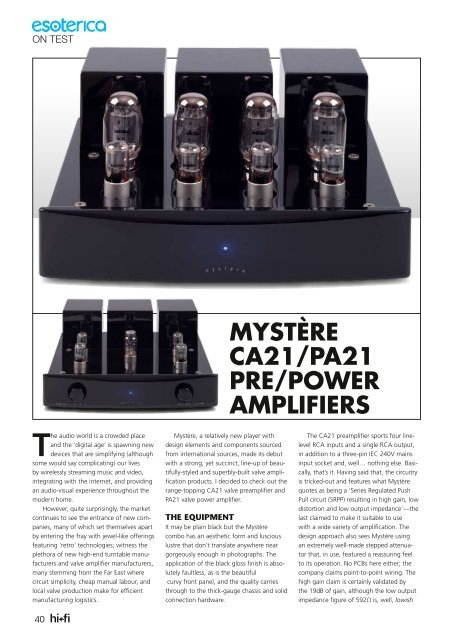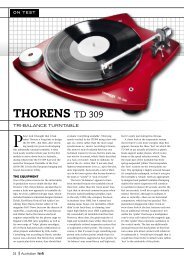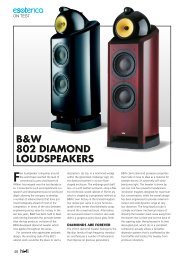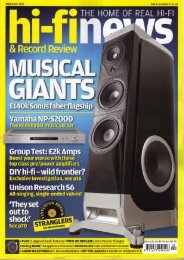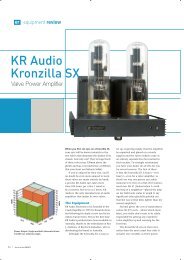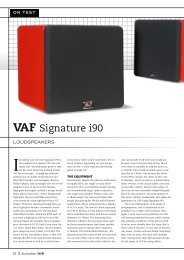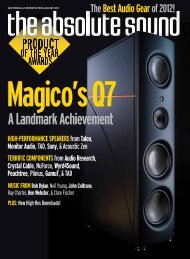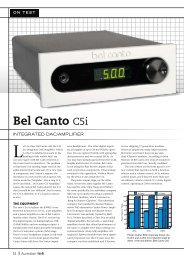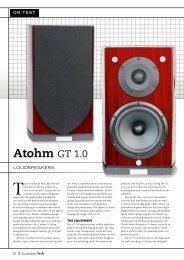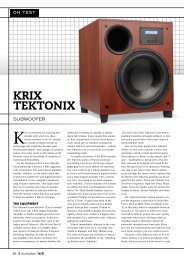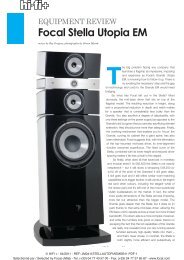here - Ultra High-End Audio and Home Theater Review
here - Ultra High-End Audio and Home Theater Review
here - Ultra High-End Audio and Home Theater Review
You also want an ePaper? Increase the reach of your titles
YUMPU automatically turns print PDFs into web optimized ePapers that Google loves.
on test<br />
Mystère<br />
CA21/PA21<br />
Pre/Power<br />
AMPLIFIERS<br />
The audio world is a crowded place<br />
<strong>and</strong> the ‘digital age’ is spawning new<br />
devices that are simplifying (although<br />
some would say complicating) our lives<br />
by wirelessly streaming music <strong>and</strong> video,<br />
integrating with the internet, <strong>and</strong> providing<br />
an audio-visual experience throughout the<br />
modern home.<br />
However, quite surprisingly, the market<br />
continues to see the entrance of new companies,<br />
many of which set themselves apart<br />
by entering the fray with jewel-like offerings<br />
featuring ‘retro’ technologies; witness the<br />
plethora of new high-end turntable manufacturers<br />
<strong>and</strong> valve amplifier manufacturers,<br />
many stemming from the Far East w<strong>here</strong><br />
circuit simplicity, cheap manual labour, <strong>and</strong><br />
local valve production make for efficient<br />
manufacturing logistics.<br />
40<br />
Mystère, a relatively new player with<br />
design elements <strong>and</strong> components sourced<br />
from international sources, made its debut<br />
with a strong, yet succinct, line-up of beautifully-styled<br />
<strong>and</strong> superbly-built valve amplification<br />
products. I decided to check out the<br />
range-topping CA21 valve preamplifier <strong>and</strong><br />
PA21 valve power amplifier.<br />
The Equipment<br />
It may be plain black but the Mystère<br />
combo has an aesthetic form <strong>and</strong> luscious<br />
lustre that don’t translate anyw<strong>here</strong> near<br />
gorgeously enough in photographs. The<br />
application of the black gloss finish is absolutely<br />
faultless, as is the beautiful<br />
curvy front panel, <strong>and</strong> the quality carries<br />
through to the thick-gauge chassis <strong>and</strong> solid<br />
connection hardware.<br />
The CA21 preamplifier sports four linelevel<br />
RCA inputs <strong>and</strong> a single RCA output,<br />
in addition to a three-pin IEC 240V mains<br />
input socket <strong>and</strong>, well… nothing else. Basically,<br />
that’s it. Having said that, the circuitry<br />
is tricked-out <strong>and</strong> features what Mystère<br />
quotes as being a ‘Series Regulated Push<br />
Pull circuit (SRPP) resulting in high gain, low<br />
distortion <strong>and</strong> low output impedance’—the<br />
last claimed to make it suitable to use<br />
with a wide variety of amplification. The<br />
design approach also sees Mystère using<br />
an extremely well-made stepped attenuator<br />
that, in use, featured a reassuring feel<br />
to its operation. No PCBs <strong>here</strong> either; the<br />
company claims point-to-point wiring. The<br />
high gain claim is certainly validated by<br />
the 19dB of gain, although the low output<br />
impedance figure of 592Ω is, well, lowish
On TEST<br />
rather than low. Distortion is well constrained<br />
with a specced figure of 0.03 per<br />
cent. Mystère rates frequency response at<br />
8Hz to 200kHz. Valve configuration sees the<br />
use of four 6SN7 input valves <strong>and</strong> one 5AR4<br />
regulator. Oh, <strong>and</strong> if you judge the quality<br />
of your audio components by the kilo,<br />
this one would be a doozie; it’s one of the<br />
heaviest preamps I’ve had the displeasure of<br />
lifting—all 20kg of it.<br />
The PA21 power amplifier is just as solidly<br />
put together <strong>and</strong> specced. The circuit is<br />
a push-pull pentode design that auto-biases<br />
the valves (what the company calls Adaptive<br />
AutoBias) so they’re operating at optimum<br />
levels. The amp claims an output power<br />
of 55-watts continuous per channel into<br />
an 8Ω load with 1 per cent total harmonic<br />
distortion. Like all valve amplifiers, if your<br />
speakers have a nominal impedance of 4Ω,<br />
you need to use the 4Ω speaker terminals<br />
on the PA21. Gain is a healthy 26dB which<br />
makes for an ideal gain structure when in<br />
use with the CA21. The PA21’s b<strong>and</strong>width<br />
reportedly spans 4Hz to 80kHz ±0.3dB at<br />
1-watt <strong>and</strong> 9Hz–52kHz ±1dB at 40-watts.<br />
T<strong>here</strong>’s a fair bit of weight <strong>here</strong> too, 27kg<br />
in fact—not back-breaking but awkward<br />
enough especially since the agglomeration<br />
of triple transformers at the rear presents an<br />
unbalanced lift.<br />
Once again, the rear panel is simplicity<br />
itself; just a single set of quality RCA inputs,<br />
an IEC 240V mains socket <strong>and</strong> the 4Ω <strong>and</strong> 8Ω<br />
output transformer taps (with no indication of<br />
which ones are for the left channel <strong>and</strong> which<br />
for the right) for your speaker connections. A<br />
side-mounted switch toggles between EL34<br />
<strong>and</strong> KT88 power valves… obviously, having<br />
this set to the appropriate setting for the set<br />
of valves that’s fitted is crucial in order to<br />
achieve the correct biasing!<br />
It’s very easy to access, so could easily be<br />
inadvertently set incorrectly, particularly by<br />
someone hunting for the mains power switch<br />
which is in the same position, but on the<br />
opposite (right-h<strong>and</strong>) side of the amplifier.<br />
The PA21 I reviewed came equipped with<br />
Chinese-made KT88s (four) <strong>and</strong> 6SN7s (four).<br />
Both components feature a removable<br />
valve-protecting cage that’s both practical<br />
<strong>and</strong> pretty, but removing it <strong>and</strong> exposing<br />
the beauty of the glowing valves makes it<br />
all the more cool.<br />
Mysterious Sound<br />
I hooked up to my Metronome T1i CD<br />
source <strong>and</strong> Wilson <strong>Audio</strong> Sasha speakers<br />
via the usual quality cable loom <strong>and</strong> was<br />
pleased to hear very little in the way of<br />
noise or valve rush—a promising sign. However<br />
soon after the initial few hours of operation<br />
the PA21 developed a faulty valve…<br />
crackling <strong>and</strong> popping like Kellogg’s. The<br />
moral? Keep spare valves on h<strong>and</strong>—although<br />
anyone who purchases these little<br />
jewels would be well-aware that when<br />
using valve gear, having spares—no matter<br />
how long a life the manufacturer quotes—is<br />
a given. And indeed, Mystère encourages<br />
experimentation, not only in terms of valve<br />
‘rolling’, but also hinting at the subtle sonic<br />
improvements that using valve damping<br />
rings <strong>and</strong> other accessories may reap.<br />
Sonically, the Mystère combo delivered<br />
on the promise that good valve equipment<br />
implies. The sound had a solidity <strong>and</strong> body,<br />
especially throughout the midrange, that<br />
imparted the impression of real vocalists<br />
<strong>and</strong> backing instrumentalists. All that in a<br />
resolute <strong>and</strong> tonally liquid <strong>and</strong> precise sonic<br />
signature that encouraged extended listening.<br />
Feed this combo a well-produced rock<br />
CD, something like Tool’s Aenima or Red<br />
Mystère CA21<br />
Preamplifier &<br />
PA21 Power Amplifier<br />
Br<strong>and</strong>: Mystère<br />
Model: CA21/PA21<br />
Category: Pre & Power Amplifiers<br />
RRP: $2,695 (CA21) <strong>and</strong> $3,795 (PA21)<br />
Warranty: One Year<br />
Distributor: Advance <strong>Audio</strong> Australia<br />
Address: Unit 8, 509–529 Parramatta Road<br />
Leichhardt<br />
NSW 2040<br />
T: (02) 9561 0799<br />
F: (02) 9569 1085<br />
E: sales@advanceaudio.com.au<br />
W: www.advanceaudio.com.au<br />
Superb build quality <strong>and</strong> finish<br />
Beautiful sonic signature<br />
Good bass control<br />
Some users would appreciate<br />
a remote control<br />
No rear-panel channel<br />
identification (PA21)<br />
Too-easy-to-access bias switch<br />
Hot Chilli Pepper’s Blood, Sugar, Sex, Magic<br />
<strong>and</strong> it will deliver a wealth of tight, punchy<br />
<strong>and</strong> plenty-low bass.<br />
The highs were nicely extended too, with<br />
cymbals <strong>and</strong> triangles shimmering off with<br />
air <strong>and</strong> harmonic content that trailed off<br />
with delicious-sounding decay. Put on an<br />
orchestral piece, such as the Sibelius Violin<br />
Concerto with Itzhak Perlman (one of my<br />
favourites) <strong>and</strong> you’ll also delight in the<br />
massive soundscape—laterally <strong>and</strong> medially.<br />
Given the appropriate speakers (I am<br />
unsure of the amplifier’s load tolerances but<br />
the lab’s findings should be of interest) the<br />
combo can sound quite dynamic <strong>and</strong> clean<br />
with good micro-detail… if not the fastest<br />
transient attack.<br />
Conclusion<br />
This Mystère CA21 <strong>and</strong> PA21 combo is<br />
a splendid offering from a relatively new<br />
player on the high-end audio scene. The<br />
amplifiers are lusciously presented in faultless<br />
gloss black with heavy-gauge casework<br />
<strong>and</strong> connections that seem as though<br />
they will last a lifetime. The fit <strong>and</strong> finish is<br />
outst<strong>and</strong>ing.<br />
This all-valve duo presents a sonic picture<br />
that is brimming with detail, dynamic<br />
contrast <strong>and</strong> body <strong>and</strong> soul. To me, that’s<br />
territory that’s tread only by truly great valve<br />
designs… Edgar Kramer<br />
41
Lab Report<br />
Mystère CA21 Preamplifier <strong>and</strong> PA21 Power Amplifier<br />
Readers interested in a<br />
full technical appraisal<br />
of the performance<br />
of the Mystère CA21<br />
preamplifier <strong>and</strong><br />
Mystère PA21 power amplifier should<br />
continue on <strong>and</strong> read the LABORATORY<br />
REPORT published on the following<br />
pages. Readers should note that the<br />
results mentioned in the report, tabulated<br />
in performance charts <strong>and</strong>/or displayed<br />
using graphs <strong>and</strong>/or photographs should<br />
be construed as applying only to the<br />
specific sample tested.<br />
Test Results<br />
Australian Hi-Fi’s editor, Greg Borrowman,<br />
commissioned Newport Test Labs to test<br />
this duo together, rather than separately,<br />
because this is the format Edgar Kramer<br />
used for his subjective listening sessions,<br />
<strong>and</strong> will be the way most people will<br />
experience these Mystère components.<br />
Although I can see the point of doing it this<br />
way (<strong>and</strong> appreciate the savings in lab time<br />
Newport Test Labs<br />
Power Output: Single channel driven into<br />
8-ohm <strong>and</strong> 4-ohm non-inductive loads at<br />
20Hz, 1kHz <strong>and</strong> 20kHz. [Mystere PA21]<br />
Newport Test Labs<br />
Power Output: Both channels driven into<br />
8-ohm <strong>and</strong> 4-ohm non-inductive loads at<br />
20Hz, 1kHz <strong>and</strong> 20kHz. [Mystere PA21]<br />
<strong>and</strong> space in the magazine) I can’t help but<br />
think that many might use the PA21 not<br />
with the CA21 but instead with a passive<br />
pre, or with a DAC/pre with its own volume<br />
control, so a separate test of the power<br />
amp on its own might have been called for.<br />
Anyway, it does mean that readers should<br />
bear in mind that this testing methodology<br />
means that (other than in the area of power<br />
output) you can’t compare Newport Test<br />
Labs’ results with the manufacturer’s own<br />
specifications.<br />
Since I’ve mentioned power output, the<br />
Mystère PA21 delivered 45-watts per channel,<br />
both channels driven into 8 ohms <strong>and</strong><br />
45-watts per channel, both channels driven<br />
into 4Ω, when using the 8Ω output transformer<br />
taps. Both figures fall short of Mystère’s<br />
claim of 55-watts per channel, but it’s<br />
obvious from the power output table (page<br />
71) that this specification is the less-often<br />
used ‘single-channel-driven’ figure, <strong>and</strong><br />
also only when a 4Ω load is used. Newport<br />
Test Labs measured single-channel power<br />
outputs of 50-watts per channel with an<br />
8Ω load <strong>and</strong> 55-watts with a 4Ω load. This<br />
output level was not sustained at the frequency<br />
extremes, with the PA21 delivering<br />
just 30-watts at 20Hz, both channels driven<br />
into 8Ω, <strong>and</strong> 36-watts per channel at 20kHz<br />
under the same conditions. In Australia,<br />
because power output must be stated as<br />
the minimum figure over a 20Hz to 20kHz<br />
b<strong>and</strong>width, this would put the Mystère’s<br />
power output at 32-watts per channel into<br />
8Ω <strong>and</strong> 33-watts per channel into 4Ω. Note<br />
that all figures were measured using 8Ω <strong>and</strong><br />
4Ω laboratory test loads connected (alternately!)<br />
to the 8Ω output transformer taps.<br />
The 4Ω taps were not tested.<br />
The frequency response of the CA21/<br />
PA21 combo was excellent, being very<br />
extended. Newport Test Labs measured the<br />
1dB downpoints at 6.5Hz <strong>and</strong> 190kHz, <strong>and</strong><br />
the 3dB downpoints at 2.3Hz <strong>and</strong> 200kHz.<br />
However, the lab identified a considerable<br />
(4.2dB) peak centred at 170kHz, so the<br />
overall frequency response could hardly be<br />
considered ‘flat’ over the wider b<strong>and</strong>width.<br />
However, it’s certainly flat across the audio<br />
b<strong>and</strong> (20Hz to 20kHz) as you can see in<br />
Graph 6. The black trace on the graph<br />
shows the response into a st<strong>and</strong>ard 8Ω noninductive<br />
laboratory resistor, <strong>and</strong> it’s just<br />
1.4dB down at 5Hz, comes up to ‘reference’<br />
at 50Hz, then tracks that reference line up<br />
to 14kHz, after which t<strong>here</strong>’s a minuscule<br />
rise in level of 0.1dB at 20kHz <strong>and</strong> 0.2dB<br />
at 30kHz. The red trace shows the PA21’s<br />
frequency response when it’s connected<br />
42
Mystère CA21 Preamplifier <strong>and</strong> PA21 Power Amplifier<br />
On TEST<br />
dBFS<br />
0.00<br />
-20.00<br />
-40.00<br />
-60.00<br />
-80.00<br />
-100.00<br />
-120.00<br />
-140.00<br />
dBFS<br />
0.00<br />
-20.00<br />
-40.00<br />
-60.00<br />
-80.00<br />
-100.00<br />
-120.00<br />
-140.00<br />
dBFS<br />
0.00<br />
-20.00<br />
-40.00<br />
-60.00<br />
-80.00<br />
-100.00<br />
-120.00<br />
-140.00<br />
Distortion was very low for a valve amplifier<br />
<strong>and</strong> quite low compared to quite a few solidstate<br />
amplifiers that don’t use negative feedback<br />
0.00 Hz 4000.00 8000.00 12000.00 16000.00 20000.00<br />
Graph 1: Total harmonic distortion (THD) at 1kHz referenced to 1-watt across an 8 ohm noninductive<br />
load, using 8-ohm output transformer tap. [Mystere C21/P21 Pre/Power Amplifiers]<br />
Newport Test Labs<br />
Newport Test Labs<br />
0.00 Hz 4000.00 8000.00 12000.00 16000.00 20000.00<br />
Graph 2: Total harmonic distortion (THD) at 1kHz referenced to 1-watt across a 4-ohm<br />
non-inductive load, using 8-ohm output transformer tap. [Mystere C21/P21 Pre/Power Amplifiers]<br />
Newport Test Labs<br />
0.00 Hz 4000.00 8000.00 12000.00 16000.00 20000.00<br />
Graph 3: Total harmonic distortion (THD) at 1kHz referenced to rated output (50-watts) across an<br />
8-ohm non-inductive load using 8-ohm output transformer tap [Mystere C21/P21 Pre/Power Amps]<br />
dBFS<br />
0.00<br />
-20.00<br />
-40.00<br />
-60.00<br />
-80.00<br />
-100.00<br />
-120.00<br />
-140.00<br />
dBFS<br />
0.00<br />
-10.00<br />
-20.00<br />
-30.00<br />
-40.00<br />
-50.00<br />
-60.00<br />
-70.00<br />
-80.00<br />
-90.00<br />
-100.00<br />
-110.00<br />
-120.00<br />
dBr<br />
3.00<br />
2.00<br />
1.00<br />
0.00<br />
-1.00<br />
-2.00<br />
-3.00<br />
Newport Test Labs<br />
0.00 Hz 4000.00 8000.00 12000.00 16000.00 20000.00<br />
Graph 4: Total harmonic distortion (THD) at 1kHz at 54-watts) across a 4-ohm non-inductive load,<br />
using 8-ohm output transformer taps. [Mystere C21/P21 Pre/Power Amplifiers]<br />
Newport Test Labs<br />
0.00 Hz 4000.00 8000.00 12000.00 16000.00 20000.00 24000.00 28000.00<br />
Graph 5: Intermodulation distortion (CCIF-IMD) using test signals at 19kHz <strong>and</strong> 20kHz, referenced<br />
to a 1-watt output (at 0dB) across an 8-ohm non-inductive load. [Mystere C21/P21 Pre/Power]<br />
Newport Test Labs<br />
10.00 Hz 100.00 1000.00 10000.00 30000.00<br />
Graph 6: Frequency response of line input referenced to a 1 watt output (at 0dB) across an<br />
8-ohm non-inductive load (Black Trace) <strong>and</strong> across a combination resistive/inductive/capacitive<br />
load representative of a typical two-way loudspeaker system (Red Trace). [Mystere C21/P21]<br />
to a load that simulates that of a two-way<br />
bookshelf loudspeaker. (Editor’s Note: As it<br />
happens, it’s exactly the same load used by<br />
US magazine Stereophile, which is a customisation<br />
of a circuit originally developed<br />
by Ken Kantor <strong>and</strong> the conclusion of an<br />
interview with Kantor that commenced in<br />
the last issue of Australian Hi-Fi Magazine,<br />
appears in this very issue, on page 32!) You<br />
can see that into such a load, the response<br />
varies quite a bit, though the extent is<br />
exaggerated by the graph’s extreme vertical<br />
scale. In fact, the frequency response, even<br />
into this simulated loudspeaker load, is still<br />
an excellent 20Hz to 20kHz ±1.5dB.<br />
Channel balance was inspiringly good,<br />
at 0.7dB (at 1kHz) <strong>and</strong> channel separation<br />
was also good, particularly at low frequencies<br />
(95dB at 20Hz, <strong>and</strong> still 81dB at 1kHz).<br />
It diminished at higher frequencies, though<br />
the measured result of 54dB at 20kHz is<br />
more than is necessary to deliver not only<br />
adequate channel separation, but also<br />
realistic stereo imaging. Inter-channel phase<br />
errors were about what I’d expect for a<br />
valve amplifier, though the figure of 9.4° at<br />
20kHz is a bit high: It would, however, be<br />
completely inaudible.<br />
Distortion was very low for a valve<br />
amplifier (<strong>and</strong> quite low compared to quite<br />
a few solid-state amplifiers, particularly<br />
those that don’t employ negative feedback).<br />
At an output of one watt into 8Ω<br />
the spectral analysis (Graph 1) shows just<br />
second, third <strong>and</strong> fourth harmonics, at<br />
–65dB (0.056%THD), –70dB (0.031%) <strong>and</strong><br />
CONTINUED ON PAGE 71<br />
43
Mystère CA21 Preamplifier <strong>and</strong> PA21 Power Amplifier<br />
Lab Report<br />
CONTINUED FROM PAGE 43<br />
–100dB (0.001%). Above 2kHz the noise<br />
floor is sitting down at around –112dB, but<br />
t<strong>here</strong> are power-supply-related hum <strong>and</strong><br />
harmonics to the left of the fundamental<br />
raising the low-frequency noise floor, with<br />
the peak component at around –62dB. Reducing<br />
the load resistance to 4Ω (Graph 2)<br />
sees an increase in the number of harmonic<br />
distortion components <strong>and</strong> corresponding<br />
increases in level, such that the harmonic<br />
distortion series now extends out to the 6 th ,<br />
with the 2 nd harmonic at –57dB (0.141%).<br />
The level of the noise floor <strong>and</strong> hum components<br />
remain almost identical, despite the<br />
reduction in load resistance.<br />
Increasing output to 50-watts sees distortion<br />
rise considerably (Graph 3). The second<br />
harmonic distortion component is now<br />
at –50dB (0.315%) <strong>and</strong> the third is even<br />
higher, at –47dB (0.446%). The harmonic<br />
series now also extends right across the<br />
audio b<strong>and</strong>, to the 20 th , at 20kHz. However,<br />
the only ‘significant’ components (other<br />
than the first <strong>and</strong> second) are 7 th -order<br />
<strong>and</strong> below, <strong>and</strong> these are still all more than<br />
70dB down (individually contributing less<br />
than 0.031%). The look of the harmonic<br />
structure made me suspect that the amplifier<br />
was being slightly overdriven when this<br />
graph was traced, <strong>and</strong> that backing off the<br />
volume control just one notch would have<br />
seen almost all the higher-order distortion<br />
components disappear, but I wasn’t able to<br />
request a re-test to confirm this in the time<br />
available before the magazine went to print.<br />
Output at 54-watts into 4Ω is shown in<br />
Graph 4. The second harmonic is at –46dB<br />
(0.5%) <strong>and</strong> the third is at –41dB (0.891%).<br />
Despite the forest of distortion components<br />
on the graphs, overall total harmonic distortion<br />
(THD) is still inaudibly low, with THD+N<br />
coming in at 0.07% at an output of 1-watt<br />
<strong>and</strong> just 0.53% at rated output.<br />
That low-frequency power supply noise<br />
I alluded to earlier is once again clearly<br />
evident on Graph 5, which shows CCIF<br />
intermodulation distortion. The expected<br />
regenerated signal at 1kHz is fairly low<br />
for a valve amplifier, coming in at around<br />
–68dB (0.039%), <strong>and</strong> t<strong>here</strong> are only two<br />
sideb<strong>and</strong>s around the test signals, one at<br />
18kHz (–87dB/0.005%) <strong>and</strong> one at 21kHz<br />
(–81dB/0.008%). These low levels lead me<br />
to suspect that the sound of the CA21/<br />
PA21 would be ‘cleaner’ than other valve<br />
amplifiers that exhibit higher levels of CCIF-<br />
IMD, particularly when they’re being driven<br />
hard with complex, orchestral music.<br />
As for noise levels themselves, the<br />
unweighted figures of 61dB (referenced to<br />
one-watt, in order that readers can accurately<br />
compare this Mystère combo’s noise<br />
levels against amplifiers with either higher<br />
or lower power outputs) <strong>and</strong> 75dB (referenced<br />
to rated output) are not particularly<br />
good, <strong>and</strong> have obviously been affected by<br />
Mystere PA21 Power Amplifier - Power Output (8Ω Tap)<br />
Channel Load (Ω) 20Hz<br />
(watts)<br />
20Hz<br />
(dBW)<br />
1kHz<br />
(watts)<br />
1kHz<br />
(dBW)<br />
20kHz<br />
(watts)<br />
20kHz<br />
(dBW)<br />
1 8 Ω 32 15.0 50 17.0 36 15.6<br />
2 8 Ω 30 14.7 45 16.5 34 15.3<br />
1 4 Ω 56 17.5 55 17.3 34 15.3<br />
2 4 Ω 51 17.0 45 16.5 33 15.2<br />
Note: Figures in the dBW column represent output level in decibels referred to one watt output.<br />
Mystere CA21/PA21<br />
Laboratory Test Results<br />
Test Measured Result Units/Comment<br />
Frequency Response @ 1 watt o/p 6.5Hz – 190kHz –1dB<br />
Frequency Response @ 1 watt o/p 2.3Hz – 200kHz –3dB<br />
Channel Separation (dB) 95dB / 81dB / 54dB (20Hz / 1kHz / 20kHz)<br />
Channel Balance 0.7 dB @ 1kHz<br />
Interchannel Phase 1.7 / 0.5 / 9.4 degrees ( 20Hz / 1kHz / 20kHz)<br />
THD+N 0.07% / 0.53% @ 1-watt / @ rated output<br />
Signal-to-Noise (unwghted/wghted) 61dB / 75dB dB referred to 1-watt output<br />
Signal-to-Noise (unwghted/wghted) 75dB / 88dB dB referred to rated output<br />
Input Sensitivity (CD Input) 136mV (for rated output)<br />
Power Consumption (Single Ch PA21) N/A / 183 watts (St<strong>and</strong>by / On)<br />
Power Consumption (Single Ch PA21) 187 / 251 watts at 1-watt / at rated output<br />
Power Consumption (Both Ch CA21) 49 watts<br />
Mains Voltage Variation during Test 245 – 251 Minimum – Maximum<br />
the low-frequency hum components mentioned<br />
previously. Weighting the measurements<br />
improved the figures substantially,<br />
to 75dB <strong>and</strong> 88dB respectively. Maybe<br />
these figures could be improved further in a<br />
home environment, w<strong>here</strong> t<strong>here</strong> are fewer<br />
connections to other components, <strong>and</strong> also<br />
by careful selection <strong>and</strong> routing of interconnecting<br />
<strong>and</strong> mains cables.<br />
The oscillograms obtained from the<br />
square wave testing graphically reflect the<br />
results obtained by the other instruments<br />
used by Newport Test Labs. The top of the<br />
100Hz square wave, for example, is tilted<br />
left to right, which shows that the low-frequency<br />
response rolls off with decreasing<br />
frequency. T<strong>here</strong>’s also a slight ‘bend’ in the<br />
curve, revealing some phase shift (group<br />
delay). Finally, the ‘spike’ in the leading<br />
edge reveals that high-frequency (170kHz)<br />
peak mentioned previously. The 1kHz<br />
square wave shows a little ringing, but it<br />
otherwise excellent. The 10kHz square wave<br />
shows the same ringing (exp<strong>and</strong>ed, due to<br />
the different horizontal time-base setting on<br />
the oscilloscope) but you can see the wave<br />
is still exceptionally ‘square’, demonstrating<br />
an extended high-frequency response.<br />
The oscillogram showing performance into<br />
a highly capacitive load shows very tightly<br />
controlled ringing <strong>and</strong>, interestingly, that<br />
although t<strong>here</strong>’s a slight overshoot on the<br />
trailing edge, t<strong>here</strong>’s no equivalent overshoot<br />
on the leading edge, which I assumed<br />
(but I st<strong>and</strong> to be corrected) was most likely<br />
due to tiny differences between the KT88<br />
output valves, which in turn lead me to<br />
think that Mystère is not pre-matching its<br />
valves, but instead depending on its autobiasing<br />
to correct for the inevitable slight<br />
differences between different valves.<br />
The power consumption figures show<br />
that you should really not leave either the<br />
pre or the power amplifier switched on<br />
when you’re not using it, self-evidently<br />
because of the high mains power consumption<br />
even when idling, but also because of<br />
the heat generated by both components,<br />
which is considerable, <strong>and</strong> also the fact<br />
that switching the amplifiers off will greatly<br />
extend the lives of all the valves.<br />
Overall, the test results measured by<br />
Newport Test Labs show that the Mystère<br />
CA21 <strong>and</strong> PA21 are well-designed,<br />
high-performance valve amplifiers that will<br />
deliver excellent <strong>and</strong> consistent sound quality<br />
when they’re paired with loudspeakers<br />
of moderate to high efficiency.<br />
<br />
Steve Holding<br />
71


